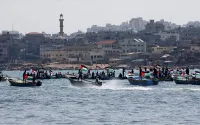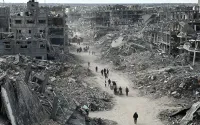by Rachel Van Dongen
Flying over the vast jungle here, a joint Colombian-American crew trolls for suspicious aircraft that could be smuggling tons of cocaine onto American soil.
When their radar locks onto a suspect plane, the crew attempts to make radio contact. If there is no response, they may fire warning shots in an attempt to get the suspect plane to land. Only as a last resort may the multinational crew seek permission from the ground to shoot the plane down.
Called the Air Bridge Denial Program, this dangerous work was abruptly terminated in April 2001 after a missionary from the United States and her baby daughter were mistakenly shot down during a similar operation in Peru. But two weeks ago, with new safeguards in place, the program was resurrected as a tool to staunch the flow of illegal drugs from the world's largest cocaine provider. The US and Peru are in the early stages of restarting interdiction over Peruvian airspace as well.
Although US officials insist that this is a Colombian-run program, two Americans will actively participate in each operation. One will be stationed at the Colombian Defense Ministry helping to monitor planes, while the other will ride along in tracker aircraft.
Yet the Americans involved are not active military men. Instead, they are part of the unofficial army of private US contractors working in Colombia, doing everything from spraying coca fields to training a Colombian antikidnapping squad. It's a formula the US has repeated from here to Afghanistan to Iraq: employing civilians to do jobs historically carried out by the armed forces.
A 10-fold increaseContractors are performing "the entire spectrum of military services," says Peter Singer, an analyst at the Brookings Institution in Washington and author of the new book, "Corporate Warriors," about the growth of the privatized military. He says US civilians in conflicts around the world do everything from handling mail services and feeding troops to training foreign troops and devising war games. Most are retired military personnel or former special forces.
In theory, US law mandates that no more than 400 civilian contractors can be on the ground in Colombia at any one time. But since US law also caps the number of US troops at 400, contractors are in even higher demand. Experts say that the US often hires nationals from places like Brazil and Central America who don't count toward the cap.
But this Andean nation is hardly the largest theater of operations for these soldiers of fortune.
Mr. Singer says nearly 10,000 private military contractors are currently working in Iraq, training a new Iraqi military, protecting the Baghdad and Basra airports, and feeding and housing US troops.
Several hundred contractors remain on the ground in Afghanistan as well, providing such services as security for President Hamid Karzai. In Liberia, the US recently hired Pacific Architects and Engineers to provide logistics for the Nigerian security force charged with keeping peace after the departure of President Charles Taylor.
Singer says the exponential growth in contractors during the 1990s - there have been nearly 10 times as many contractors used in the 2003 Iraq invasion as in the 1991 Persian Gulf War - is the result of several factors: the downsizing of the military, the fact that US troops are stretched thin because of their several global commitments, and a lack of planning by the Pentagon.
In places like Liberia and Colombia as well, the US is worried about "mission creep." Subjecting contractors instead of US military personnel to danger is far more politically viable as they often fly under the radar, with their costs and duties less known.
According to a report released by the US State Department earlier this year, there are 17 primary contracting companies working in Colombia, initially receiving some $3.5 billion.
The largest contracts have gone to companies like Lockheed Martin, DynCorp, and Northrop Grumman, but lesser-known firms like the Rendon Group (providing public relations support for the Ministry of Defense) and Science Applications International Corp. (assisting in imagery analysis) are also here.
Big companies such as DynCorp, in charge of piloting planes that spray coca crops, and Northrop Grumman's California Microwave Systems (CMS), which operates counternarcotics missions, did not release the number of employees involved in their operations. But the report counts at least 190 contractors employed by "Plan Colombia," a US-backed antinarcotics and antiterrorism program, and estimates the risk to most of their lives as "low."
At riskBut there is still risk. In February, a single-engine Cessna carrying four Defense Department contractors working for CMS, crashed in the jungle. Former US Air Force officer Thomas John Janis and a Colombian air force sergeant were instantly executed by the Revolutionary Armed Forces of Colombia (FARC).
Three other Americans, Marc Gonsalves, Keith Stansell, and Tom Howes were abducted and have spent six months in captivity. The US government, according to the State Department report, has added "jungle survival training" to the requirements for these contractors.
Contractors may be involved in rescuing their comrades, as well as former presidential candidate Ingrid Betancourt, who has been held for 18 months by the FARC. A dramatic videotape was played Sunday on Colombian television where Ms. Betancourt called on the Colombian Army to rescue her and other hostages, and to reject FARC demands to exchange hostages for jailed rebels.
Another high-risk activity being performed by US contractors here is fumigating coca crops. Since they are often forced to pilot low-flying missions over heavy guerrilla territory, the planes are frequent targets of FARC rebels who earn substantial money from the drug trade. Over the past year, US officials have said that spray planes, required to be trailed by search-and-rescue helicopters, have been fired at by rebels 70 times.
In March, a DynCorp plane piloted by an American contractor flew into a mountainside in the southern province of Narino, apparently due to mechanical failure rather than rebel gunfire, bringing the death toll of Americans in Colombia to five in 2003.
And just last week, another spray plane crashed, this time as a result of gunfire from unidentified assailants. But the American contractor pilot was promptly rescued by the search-and-rescue contingent.






